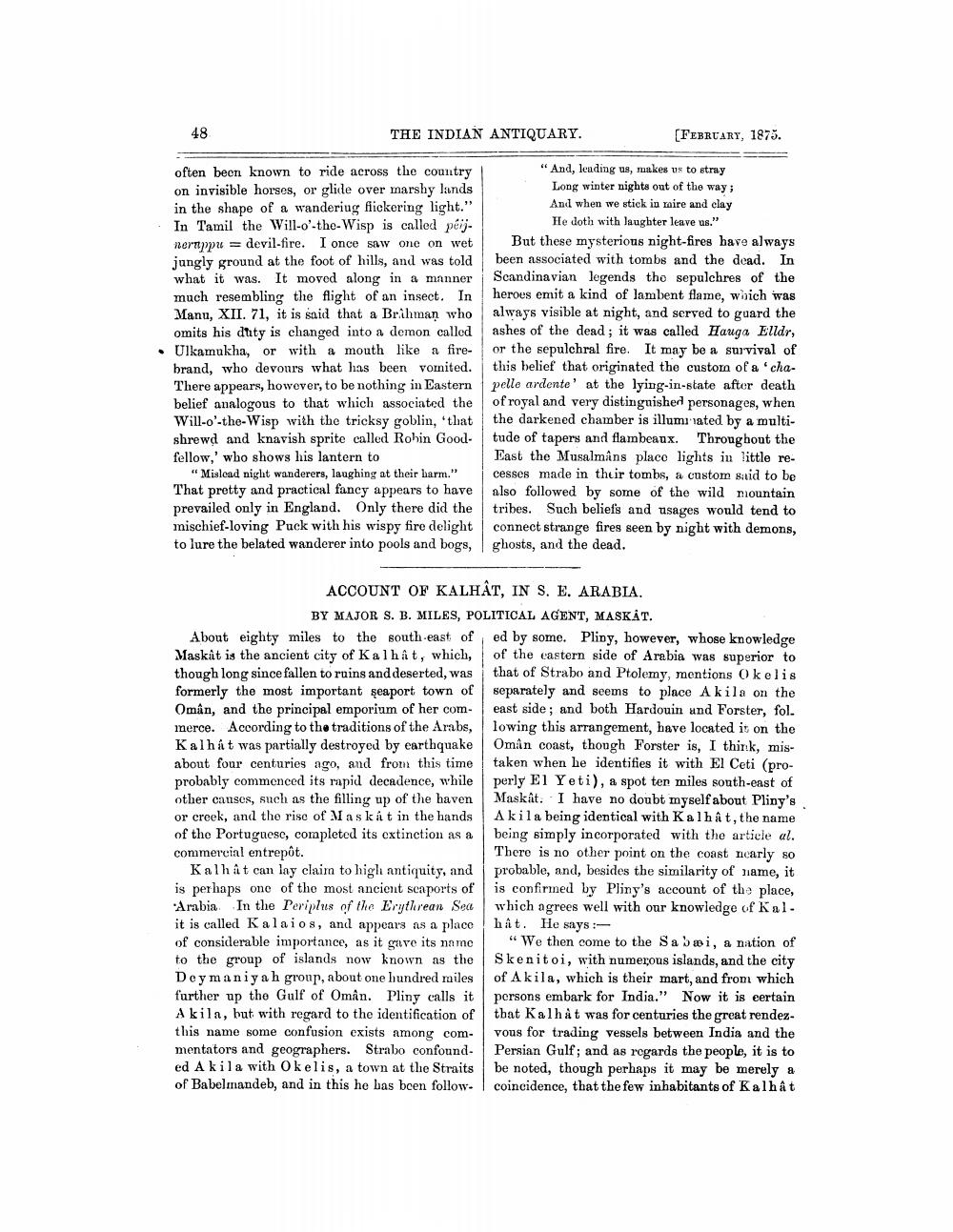________________
48
THE INDIAN ANTIQUARY.
(FEBRUARY, 1875.
often been known to ride across the country on invisible horses, or glide over marshy lands in the shape of a wanderiug flickering light." In Tamil the Will-o'-the-Wisp is called peijnerappu = devil-fire. I once saw one on wet jungly ground at the foot of hills, and was told what it was. It moved along in a manner much resembling the flight of an insect. In Manu, XII. 71, it is said that a Brihman who omits his duty is changed into a demon called Ulkamukha, or with a mouth like a firebrand, who devours what has been vomited. There appears, however, to be nothing in Eastern belief analogous to that which associated the Will-o'-the-Wisp with the tricksy goblin, that shrewd and knavish sprite called Rohin Goodfellow,' who shows his lantern to
"Mislead night wanderers, laughing at their harm." That pretty and practical fancy appears to have prevailed only in England. Only there did the mischief-loving Puck with his wispy fire delight to lure the belated wanderer into pools and bogs,
"And, leading us, makes us to stray
Long winter nights out of the way; And when we stick in rire and clay
He doth with laughter leave us." But these mysterious night-fires have always been associated with tombs and the dead. In Scandinavian legends tho sepulchres of the heroes emit a kind of lambent flame, woich was always visible at night, and served to guard the ashes of the dead; it was called Hauga Elldr, or the sepulchral fire. It may be a survival of this belief that originated the custom of a 'chapelle ardente' at the lying-in-state after death of royal and very distinguisher personages, when the darkened chamber is illuminated by a multitude of tapers and flambeaux. Throughout the East the Musalmans placo lights in little recesses made in their tombs, a custom suid to be also followed by some of the wild mountain tribes. Such beliefs and usages would tend to connect strange fires seen by night with demons, ghosts, and the dead.
ACCOUNT OF KALHÂT, IN S. E. ARABIA.
BY MAJOR S. B. MILES, POLITICAL AGENT, MASKÅT. About eighty miles to the south-east of, ed by some. Pliny, however, whose knowledge Maskât is the ancient city of Kalhật, which of the eastern side of Arabia was superior to though long since fallen to ruins and deserted, was that of Strabo and Ptolemy, mentions Okelis formerly the most important seaport town of separately and seems to place Akila on the Oman, and the principal emporium of her com- east side; and both Hardouin und Forster, fol. merce. According to the traditions of the Arabs, lowing this arrangement, have located it on the Kalhat was partially destroyed by earthquake Oman coast, though Forster is, I think, misabout four centuries ago, and from this time taken when he identifies it with El Ceti (proprobably commenced its rapid decadence, while perly El Yeti), a spot ten miles south-east of other canses, such as the filling up of the haven Maskat. I have no doubt myself about Pliny's or creek, and the rise of Maska t in the hands Akila being identical with Kalhat, the name of the Portuguese, completed its extinction as a being simply incorporated with the article al. commercial entrepôt.
There is no other point on the coast nearly so Kalhat can lay claim to high antiquity, and probable, and, besides the similarity of name, it is perhaps one of the most ancient seaports of is confirmed by Pliny's account of the place, Arabia In the Periplus of the Erythrean Sea which agrees well with our knowledge of Kal. it is called Kalaios, and appears as a place
appears as a place hat. He says :of considerable importance, as it gave its name "We then come to the Sabæi, a nation of to the group of islands now known as the Skenitoi, with numerous islands, and the city Doymaniya h group, about one hundred miles of Akila, which is their mart, and from which further up the Gulf of Oman. Pliny calls it persons embark for India." Now it is certain Akila, but with regard to the identification of that Kalhat was for centuries the great rendezthis name some confusion exists among com- vous for trading vessels between India and the mentators and geographers. Strabo confound- Persian Gulf; and as regards the people, it is to ed A kila with Okelis, a town at the Straits be noted, though perhaps it may be merely a of Babelmandeb, and in this he bas been follow. coincidence, that the few inhabitants of Kalhât




